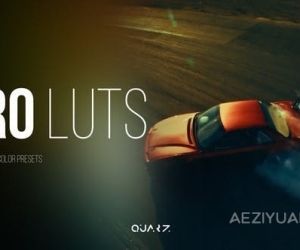马上注册,享用更多功能
您需要 登录 才可以下载或查看,没有账号?立即注册

×
Houdini中VEX与Python基础技能训练视频教程

本Houdini教程是由灵感素材分享站LGZIYUAN.COM整理的Houdini中VEX与Python基础技能训练视频教程,时长:2小时03分,大小:780 MB,MP4高清视频格式,教程使用软件:Houdini 17,附源文件,共5个章节,作者:Radu Cius,语言:英语。LGZIYUAN.COM分享。
Houdini是一个特效方面非常强大的软件。许多电影特效都是由它完成:《指环王》中“甘道夫”放的那些“魔法礼花”,还有“水马”冲垮“戒灵”的场面,后天中的龙卷风等等,a52的汽车广告,反正只要是涉及DD公司制作的好莱坞一线大片,几乎都会有Houdini参与和应用。
Houdini不光只适用于视觉特效的制作,随着HOUDINI适用于各种平台,并且出现了很多的HOUDINI培训教学,HOUDINI开始进入了动态图像设计领域。因为其自身的流程化特性,加上其强大的动力学系统,让HOUDINI在数据可视化方面占有一席重要的地位,让图形设计师能够通过它表达自己的观点。
This course covers the basics of VEX, Houdini’s expression language, as well as how to use Houdini’s Python API. We will look at the strengths and weaknesses and when you should favour one or the other. VEX is an essential tool for any technical director, so we will cover all the basics starting from its syntax, the difference between VEX and VEXpressions and how it can be used in SOPs and DOPs to optimize your systems. Later on, we will take a look at some more advanced examples like point cloud lookups and matrix transformations for dealing with deforming characters and finally creating a dissolve effect purely using VEX.
Basic knowledge of Python and understanding of object-oriented programming is recommended as the whole Python component is completely concentrated on how Python works in Houdini and understanding the Houdini Object Model. In this part, we will go over manipulating nodes, parameters and geometry using Python, as well as reading a big data set in Houdini to create a render of a country’s city lights seen during the night from space. In the final exercise, we will create a shelf tool that will gather every Geometry ROP in the scene, create Fetch ROP for each one of them, and finally merge them together to have a convenient way to cache all the geometry.
Jeronimo Maggi started his career as a 3D generalist and has been working with Houdini as an FX Artist for the last 4 years. He worked for several years in the education field teaching Houdini and currently works in Method Studios Vancouver as an FX TD. Aside from Houdini, he is also programs in Python and enjoys creating tools to speed up workflows.
CLASS 1: VEX BASICS, PART 1
In this class we go over the very basics of VEX by taking a look at its syntax as well as the concept of defining and declaring attributes, data types, and how to define vectors and access their components. We also cover the difference between VEX and Python when it comes to manipulating geometry and how its multithreaded design makes it so fast. Finally, we learn the difference between VExpressions and VEX code and how our Wrangles end up being converted.
CLASS 2: VEX BASICS, PART 2
Having learned the fundamentals in the previous class, we go over slightly more advanced concepts such as conditionals, functions, interface controls, local variables and reference variables. All these concepts will be applied in a simple dissolve effect, where we learn how to use the xyzdist and primuv functions as well as doing point cloud lookups in VEX. In the end, we have a short introduction to VExpressions in POP nodes and what are their differences.
CLASS 3: ADVANCED VEX
In this lesson we cover some more advanced VEX by looking at how to extract two non-collinear vectors out of any geometry using a for loop to create a transform matrix which we can re-apply to an animated object after fracturing it. Finally, we go over some useful VEX examples for Bullet, such as using deforming geometry and manually manipulating pieces.
CLASS 4: PYTHON BASICS
We switch from VEX to Python and have a look at Houdini's Python API: the Houdini Object Model. To better understand it, we go over some Object Oriented Programming fundamentals and then explore how we can access objects from the hou module and how they relate to each other. We cover the Node, ObjNode, SopNode, Geometry, Point, Parm, Vector3 and Attrib classes and learn about the most common methods they have.
CLASS 5: PYTHON EXAMPLES
We apply all the knowledge from class 4 into two examples. In the first one, we go over how to load a CSV file containing every town and city in the United States along with their population, so we can create lights for each one of them and create a night time render of all the cities. For the last exercise, we create a useful tool to gather every Geometry ROP node in our scene and create a Fetch ROP for each one of them before finally merging them all together. We have a look at how to avoid having duplicate fetch nodes as well as allowing our system to be run at any time and only update the fetch ROPs with the newly created Geometry ROPs.

版权声明
1. 本站出于学习和研究的目的提供平台共会员进行交流和讨论,网站资源由会员从网上收集整理所得,版权属于原作者。
2. 网站所有资源是进行学习和研究测试之用,不得以任何方式用于商业用途。请在下载后24小时删除。
3. AE资源网非常重视知识产权,如有侵犯任何第三方权益,请发邮件(aeziyuan@foxmail.com)及时联系,邮件请附(专利证书、商标注册证、著作权证书,以及知识产权人授权投诉方进行投诉的证明文件等有效证明),我们将第一时间核实并删除侵权帖子(3个工作日内处理完并邮件答复)。
本文地址: https://aeziyuan.com/thread-18579-1-1.html
|
|
 100组专业视频调色LUTs预设包 Pro LUTs for15163 人气#LUT预设
100组专业视频调色LUTs预设包 Pro LUTs for15163 人气#LUT预设 快速闪烁头像切换照片墙汇聚LOGO标志动画展15282 人气#AE模板
快速闪烁头像切换照片墙汇聚LOGO标志动画展15282 人气#AE模板 32个相机取景器图标摄像机取景框叠加工具包15061 人气#AE模板
32个相机取景器图标摄像机取景框叠加工具包15061 人气#AE模板 800种可循环响应式设计色彩鲜艳的动画背景15153 人气#PR模板
800种可循环响应式设计色彩鲜艳的动画背景15153 人气#PR模板